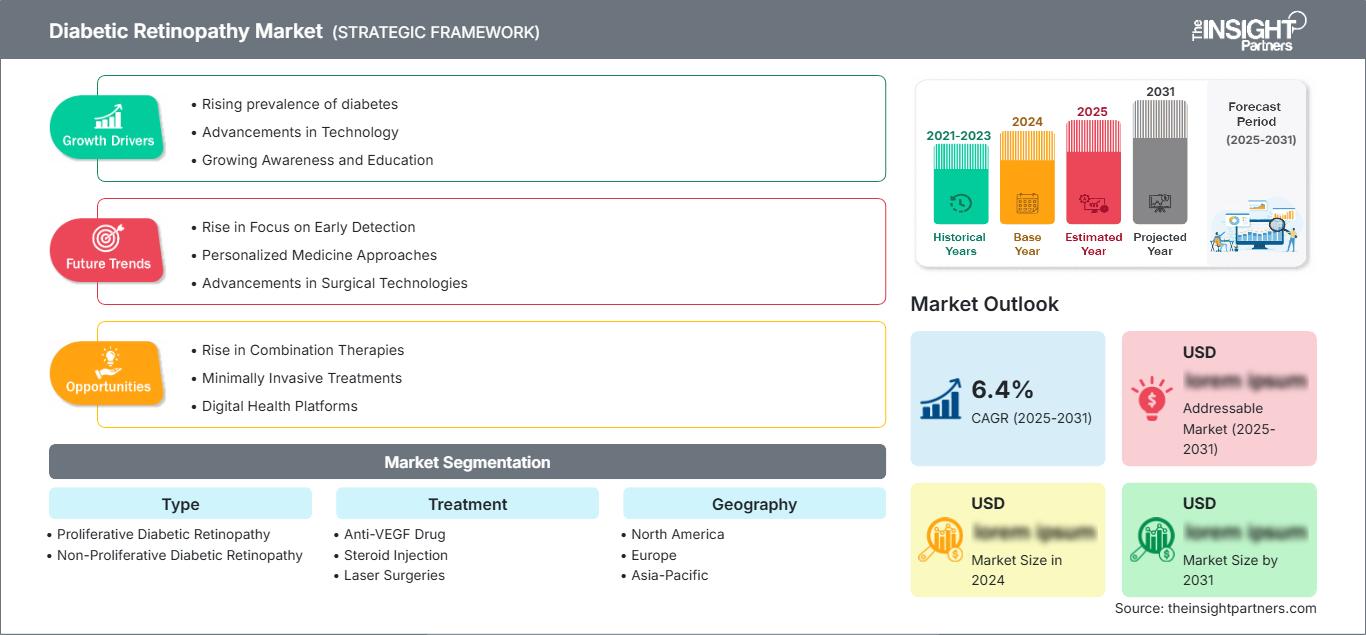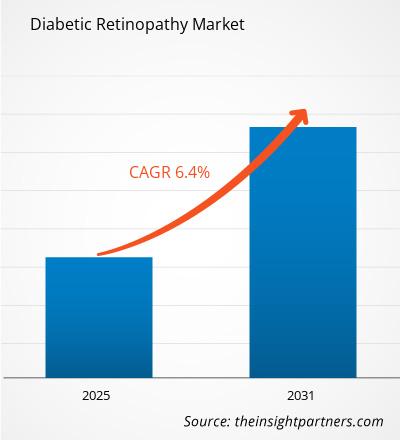Der Markt für diabetische Retinopathie wird bis 2031 voraussichtlich ein Volumen von 17,34 Milliarden US-Dollar erreichen. Für den Zeitraum 2025–2031 wird ein jährliches Wachstum von 6,5 % erwartet.
Der Bericht ist nach Typ (proliferative und nicht-proliferative diabetische Retinopathie) und Behandlung (Anti-VEGF-Medikamente, Steroidinjektionen, Laserchirurgie und Vitrektomie) segmentiert. Darüber hinaus enthält er eine Analyse basierend auf dem Vertriebskanal (Apotheken, Krankenhausapotheken und Sonstige). Die globale Analyse wird weiter auf regionaler Ebene und für wichtige Länder aufgeschlüsselt. Der Bericht gibt die Werte in US-Dollar für die oben genannten Analysen und Segmente an. Der Bericht „Markt für diabetische Retinopathie“ von The Insight Partners beschreibt die aktuelle Marktlage und das zukünftige Wachstum sowie die wichtigsten Triebkräfte, Herausforderungen und Chancen. Dies wird verschiedenen Akteuren im Geschäftsbereich Einblicke ermöglichen, wie beispielsweise:
- Technologieanbieter/Hersteller: Um die sich entwickelnde Marktdynamik zu verstehen und potenzielle Wachstumschancen zu erkennen, können sie fundierte strategische Entscheidungen treffen.
- Investoren: Um eine umfassende Trendanalyse hinsichtlich Marktwachstumsrate, Finanzprognosen und Chancen entlang der Wertschöpfungskette durchzuführen.
- Regulierungsbehörden: Um Richtlinien zu regulieren und Aktivitäten auf dem Markt zu überwachen, mit dem Ziel, Missbrauch zu minimieren, das Vertrauen der Anleger zu wahren und die Integrität und Stabilität des Marktes zu gewährleisten.
Marktsegmentierung der diabetischen Retinopathie Typ
- Proliferative diabetische Retinopathie
- Nicht-proliferative diabetische Retinopathie
Behandlung
- Anti-VEGF-Medikamente
- Steroidinjektionen
- Laserchirurgie
- Vitrektomie
Sie erhalten kostenlos Anpassungen an jedem Bericht, einschließlich Teilen dieses Berichts oder einer Analyse auf Länderebene, eines Excel-Datenpakets sowie tolle Angebote und Rabatte für Start-ups und Universitäten.
Markt für diabetische Retinopathie: Strategische Einblicke

- Holen Sie sich die wichtigsten Markttrends aus diesem Bericht.Dieses KOSTENLOSE Beispiel umfasst Datenanalysen, die von Markttrends bis hin zu Schätzungen und Prognosen reichen.
Wachstumstreiber des Marktes für diabetische Retinopathie
- Zunehmende Diabetesprävalenz: Laut der International Diabetes Federation werden bis 2040 schätzungsweise 642 Millionen Menschen weltweit an Diabetes leiden. Dies treibt die Nachfrage nach Behandlungen der diabetischen Retinopathie in die Höhe. Die steigende Zahl von Diabetesfällen ist einer der Hauptwachstumstreiber, da diabetische Retinopathie in der Regel eine Folgeerkrankung ist.
- Technologische Fortschritte: Fortschritte in Technologien wie künstlicher Intelligenz, maschinellem Lernen und anderen ermöglichen die Entwicklung immer genauerer und effizienterer Diagnoseinstrumente für diabetische Retinopathie. Verbesserungen der Behandlungsmöglichkeiten für Patienten: Technologische Fortschritte verbessern auch die Behandlungsmöglichkeiten für Patienten mit diabetischer Retinopathie.
- Wachsendes Bewusstsein und Aufklärung: Ein wachsendes Bewusstsein und eine verbesserte Aufklärung der Bevölkerung über die Notwendigkeit regelmäßiger Augenuntersuchungen und die Früherkennung diabetischer Retinopathie steigern die Nachfrage nach Behandlungen und Dienstleistungen im Bereich der diabetischen Retinopathie. Die American Diabetes Association empfiehlt Patienten mit Diabetes eine jährliche umfassende Augenuntersuchung durch einen Augenarzt. Derzeit bemühen sich die meisten Gesundheitsdienstleister, die Anzahl der Untersuchungen zu erhöhen.
Zukunftstrends im Markt für diabetische Retinopathie
- Verstärkter Fokus auf Früherkennung: Der Fokus auf die Früherkennung diabetischer Retinopathie hat aufgrund der rasanten technologischen Fortschritte und des gestiegenen Bewusstseins für deren Bedeutung zugenommen. Telemedizin und mobile Gesundheitsanwendungen ermöglichen die Fernüberwachung und Früherkennung diabetischer Retinopathie. Dies trägt zu besseren Behandlungsergebnissen bei gleichzeitig niedrigeren Gesundheitskosten bei.
- Personalisierte Medizinansätze: Personalisierte Medizinansätze, auch Präzisionsmedizin genannt, werden zunehmend zur Behandlung diabetischer Retinopathie eingesetzt. Verschiedene Gesundheitsdienstleister verschreiben maßgeschneiderte Behandlungen, die auf der genetischen Ausstattung des Patienten und der Art seiner Erkrankung basieren, um bessere Behandlungsergebnisse zu erzielen und die Behandlungskosten zu senken. Fortschritte in der chirurgischen Technologie: Verbesserte chirurgische Technologien, wie beispielsweise die Mikroinzisionschirurgie oder die Femtosekundenlaser-assistierte Kataraktchirurgie, bergen das Potenzial, die Behandlungsergebnisse für Patienten zu verbessern und die Genesungszeiten zu verkürzen. Solche Entwicklungen dürften das Marktwachstum ankurbeln, nicht zuletzt aufgrund der damit verbundenen Einsparungen und Verbesserungen in der Patientenversorgung. Marktchancen bei diabetischer Retinopathie: Zunahme von Kombinationstherapien: Der Einsatz von Kombinationstherapien, die auf verschiedene Signalwege der diabetischen Retinopathie abzielen, eröffnet neue Wege in der Behandlung dieser Erkrankung. Kombinationstherapien gelten als wirksamer als Monotherapien. Dies dürfte zu besseren Behandlungsergebnissen bei gleichzeitig geringeren Behandlungskosten führen. Minimalinvasive Behandlungen: Minimalinvasive Behandlungen wie intravitreale Injektionen und Photokoagulation entwickeln sich weiter und eröffnen neue Wege in der Behandlung der diabetischen Retinopathie. Minimalinvasive Behandlungen sind deutlich schonender als klassische chirurgische Verfahren und zielen daher darauf ab, das Risiko für den Patienten zu minimieren und die Genesungszeit zu verkürzen. Digitale Gesundheitsplattformen wie Telemedizin und mobile Gesundheits-Apps ermöglichen die Fernbehandlung der diabetischen Retinopathie. Diese Plattformen können die Patientenbeteiligung und die Therapietreue optimieren und somit die Gesundheitskosten senken und die Behandlungsergebnisse verbessern.
Markt für diabetische Retinopathie
Die regionalen Trends und Einflussfaktoren auf den Markt für diabetische Retinopathie im gesamten Prognosezeitraum wurden von den Analysten von The Insight Partners ausführlich erläutert. Dieser Abschnitt behandelt außerdem die Marktsegmente und die geografische Verteilung des Marktes für das Management von Herzrhythmusstörungen in Nordamerika, Europa, dem asiatisch-pazifischen Raum, dem Nahen Osten und Afrika sowie Süd- und Mittelamerika.
Umfang des Marktberichts zu diabetischer Retinopathie
Berichtsattribut Einzelheiten Marktgröße in 2024 US$ XX Billion Marktgröße nach 2031 US$ 17.34 Billion Globale CAGR (2025 - 2031) 6.5% Historische Daten 2021-2023 Prognosezeitraum 2025-2031 Abgedeckte Segmente By Typ - Proliferative diabetische Retinopathie
- nicht-proliferative diabetische Retinopathie
- Anti-VEGF-Medikament
- Steroidinjektion
- Laseroperationen
- Vitrektomie
- Nordamerika
- Europa
- Asien-Pazifik
- Süd- und Mittelamerika
- Naher Osten und Afrika
Abgedeckte Regionen und Länder Nordamerika - USA
- Kanada
- Mexiko
- Großbritannien
- Deutschland
- Frankreich
- Russland
- Italien
- Restliches Europa
- China
- Indien
- Japan
- Australien
- Restlicher Asien-Pazifik
- Brasilien
- Argentinien
- Restliches Süd- und Mittelamerika
- Südafrika
- Saudi-Arabien
- Vereinigte Arabische Emirate
- Restlicher Naher Osten und Afrika
Marktführer und wichtige Unternehmensprofile - Abbott Laboratories
- Alimera Science
- Allergan Plc
- Ampio Pharmaceuticals
- Bayer AG
- F. Hoffmann-LA Roche
- Novartis International AG
- PFIZER
- Regeneron Pharmaceuticals Inc
Dichte der Marktteilnehmer im Bereich der diabetischen Retinopathie: Auswirkungen auf die Geschäftsdynamik
Der Markt für diabetische Retinopathie wächst rasant, angetrieben durch die steigende Nachfrage der Endverbraucher. Gründe hierfür sind unter anderem sich wandelnde Verbraucherpräferenzen, technologische Fortschritte und ein wachsendes Bewusstsein für die Vorteile des Produkts. Mit steigender Nachfrage erweitern Unternehmen ihr Angebot, entwickeln innovative Lösungen, um den Bedürfnissen der Verbraucher gerecht zu werden, und nutzen neue Trends, was das Marktwachstum zusätzlich beflügelt.

- Holen Sie sich die Markt für diabetische Retinopathie Übersicht der wichtigsten Akteure
Wichtigste Verkaufsargumente
- Umfassende Abdeckung: Der Bericht bietet eine umfassende Analyse der Produkte, Dienstleistungen, Typen und Endnutzer des Marktes für diabetische Retinopathie und vermittelt so ein ganzheitliches Bild.
- Expertenanalyse: Der Bericht basiert auf dem fundierten Wissen von Branchenexperten und Analysten.
- Aktuelle Informationen: Der Bericht gewährleistet Geschäftsrelevanz durch die Berücksichtigung aktueller Informationen und Datentrends.
- Anpassungsmöglichkeiten: Dieser Bericht kann an spezifische Kundenanforderungen angepasst werden und sich optimal in die Geschäftsstrategien integrieren.
Der Forschungsbericht zum Markt für diabetische Retinopathie kann somit maßgeblich dazu beitragen, das Branchenszenario und die Wachstumsaussichten zu entschlüsseln und zu verstehen. Auch wenn einige berechtigte Bedenken bestehen, überwiegen die Vorteile dieses Berichts insgesamt die Nachteile.
- Historische Analyse (2 Jahre), Basisjahr, Prognose (7 Jahre) mit CAGR
- PEST- und SWOT-Analyse
- Marktgröße Wert/Volumen – Global, Regional, Land
- Branchen- und Wettbewerbslandschaft
- Excel-Datensatz
Aktuelle Berichte
Verwandte Berichte
Erfahrungsberichte
Grund zum Kauf
- Fundierte Entscheidungsfindung
- Marktdynamik verstehen
- Wettbewerbsanalyse
- Kundeneinblicke
- Marktprognosen
- Risikominimierung
- Strategische Planung
- Investitionsbegründung
- Identifizierung neuer Märkte
- Verbesserung von Marketingstrategien
- Steigerung der Betriebseffizienz
- Anpassung an regulatorische Trends




















 Kostenlose Probe anfordern für - Markt für diabetische Retinopathie
Kostenlose Probe anfordern für - Markt für diabetische Retinopathie